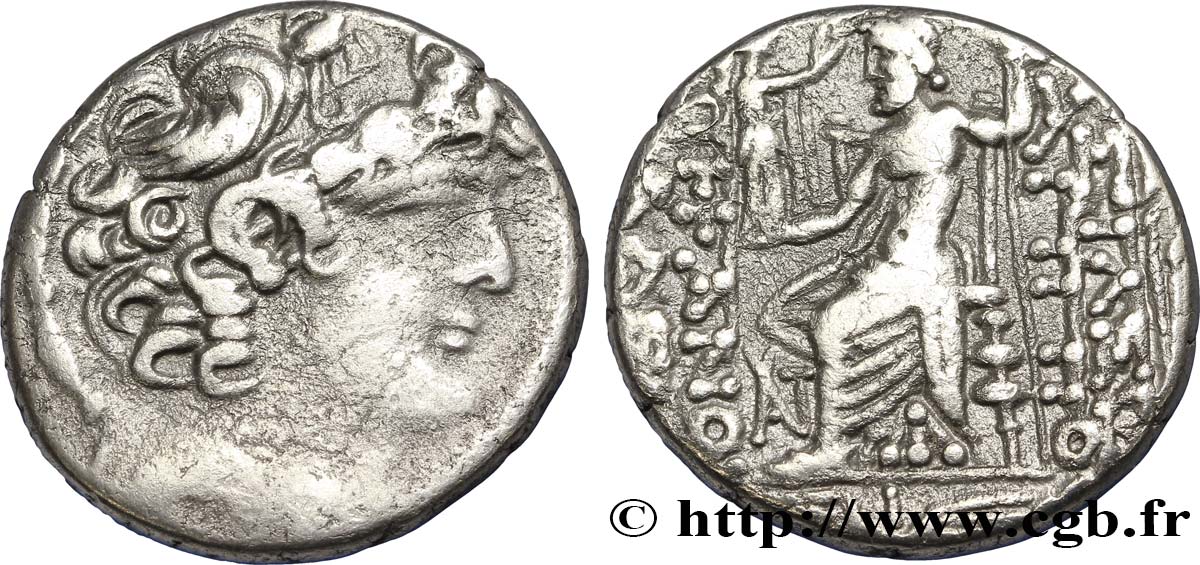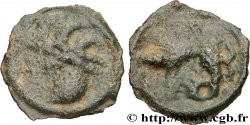E-auction 100-52743 - bpv_295677 - SIRIA - PROVINCIA ROMANA - LABIENUS Tétradrachme syro-phénicien
Devi Sign-in ed essere un offerente approvato fare un'offerta, Login per fare offerte. Conti sono soggetti ad approvazione e di approvazione sono raggiunti entro 48 ore. Non aspettare fino al giorno di una vendita si chiude per registrarti.Confermando la tua offerta su questo oggetto ti impegni ad un contratto legalmente vincolante per l'acquisto di questo prodotto e fare clic su «offerta» costituisce accettazione dei termini di utilizzo de e-auctions cgb.fr.
Offerta deve essere collocato in euro gli importi interi vendita only.The si chiuderà al momento sulla descrizione dell'oggetto, eventuali offerte pervenute al sito dopo l'orario di chiusura non verranno eseguite. Volte transmition possono variare e le offerte potrebbero essere respinto se si attende per gli ultimi secondi. Per ulteriori informazioni ckeck le FAQ.
SENZA COSTI PER GLI ACQUIRENTI.
SENZA COSTI PER GLI ACQUIRENTI.
| Valutazione : | 350 € |
| Prezzo : | 195 € |
| Offerta maxima : | 200 € |
| Data di fine vendita : | 16 marzo 2015 15:28:30 |
| partecipanti : | 12 partecipanti |
Tipo : Tétradrachme syro-phénicien
Data: 40-39 AC.
Nome della officina / città: Antioche, Syrie, Séleucie et Piérie
Metallo : argento
Diametro : 26 mm
Asse di coniazione : 12 h.
Peso : 14,80 g.
Grado di rarità : R3
Commenti sullo stato di conservazione:
Flan court mais date certaine
N° nelle opere di riferimento :
Pedigree :
Notre exemplaire est le 0010_002 de la base TSP, et provient de la trouvaille de Livia et de la Collection Richard McAlee. C’est cet exemplaire qui illustre le type dans l’ouvrage de Richard McAlee The coins of Roman Antioch, page 69, n°10
Diritto
Titolatura diritto : ANÉPIGRAPHE.
Descrittivo diritto : Tête diadémée de Philippe Philadelphe à droite, entouré de la stemma (O’).
Rovescio
Descrittivo rovescio : Zeus assis à gauche sur un trône avec dossier, tenant de la main droite une Niké qui le couronne et un sceptre long de la main gauche ; au-dessus de Zeus, le foudre ; monogramme dans le champ à gauche ; date à l’exergue.
Legenda rovescio : BASILEWS/ FILIPPOU/ EPIFANOUS/ FILADELFOU, I(Basilews Filippou Epifanous Filadelfou)
Traduzione rovescio : (Roi Philippe Epiphane Philadelphe/ monogramme d’Antioche et millésime 10 à l’exergue).
Commento
An 10 de l’ère césarienne, exemplaire classique de la série intermédiaire entre les frappes séleucides et les frappes impériales syriennes.
Rien ne marque sur ce type la présence au pouvoir à Antioche d’un traître à Rome et à César, Labienus. Notons pourtant la rareté particulière des émissions de cette année 10 de l’ère césarienne, le métal monétaire ayant peut-être été utilisé pour les frappes à légendes latine.
La colonisation romaine est encore discrète et la prise de contrôle est aimable avec des constructions d’amphithéâtres, des travaux publics et des cérémonies. La monnaie, bien que contrôlée par Rome, reste au type séleucide et seul le petit monogramme indique la prise de pouvoir, ainsi que le millésime, ici l’an 10 de l’ère césarienne.
Notons que l’ère césarienne est conservée pour dater la monnaie, bien que le pouvoir politique à Antioche soit aux mains des Pompéiens.
Style classique pour l’émission avec les mèches traitées en “serpents”.
Les émissions au type immobilisé de Philippe Philadelphe sont très importantes car elles illustrent parfaitement la logique impériale de la colonisation romaine. Autant une conquête de revendication territoriale d'expansion de l'espace vital autour d'un pouvoir central de type national va chercher à éliminer toutes les symboliques locales dans les pays conquis pour imposer celles du conquérant (selon le principe de un peuple, un roi, une foi, une loi), autant un empire va laisser cohabiter des symboliques différentes. C'est ce qui se passe en Syrie, Palestine et Phénicie dans les premiers temps de l'expansion. Loin d'imposer le denier ou la typologie romaine, les Latins vont respecter la métrologie et même le type. Il faudra attendre les rares émissions d'Auguste au revers du Zeus, presque cinquante ans, pour voir apparaître le portrait du Prince sur les monnaies locales en argent.
Dans la base TSP maintenue par Michel Prieur, cinq exemplaires sont maintenant répertoriés, dont un au British Museum 1926-11-10-1.
Year 10 of the Caesarian era, a classic example of the intermediate series between the Seleucid and the Syrian imperial strikes.
Nothing about this type indicates the presence in power in Antioch of a traitor to Rome and Caesar, Labienus.. However, let us note the particular rarity of the issues of this year 10 of the Caesarian era, the monetary metal having perhaps been used for the strikes with Latin legends.
Roman colonization is still discreet and the takeover is friendly with the construction of amphitheaters, public works and ceremonies. The coin, although controlled by Rome, remains of the Seleucid type and only the small monogram indicates the seizure of power, as well as the year, here the year 10 of the Caesarian era..
Note that the Caesarean era is retained to date the coin, although political power in Antioch was in the hands of the Pompeians.
Classic style for the show with the strands treated in “snakes”.
The immobilized type emissions of Philippe Philadelphe are very important because they perfectly illustrate the imperial logic of Roman colonization.. Just as a conquest of territorial claim of expansion of the living space around a central power of national type will seek to eliminate all local symbols in the conquered countries to impose those of the conqueror (according to the principle of one people, one king, one faith, one law), so an empire will allow different symbols to coexist. This is what happened in Syria, Palestine and Phoenicia in the early days of expansion.. Far from imposing the denarius or Roman typology, the Latins will respect metrology and even the type. It was not until the rare issues of Augustus on the reverse of the Zeus, almost fifty years later, that the portrait of the Prince appeared on local silver coins..
In the TSP database maintained by Michel Prieur, five examples are now listed, including one at the British Museum 1926-11-10-1
Rien ne marque sur ce type la présence au pouvoir à Antioche d’un traître à Rome et à César, Labienus. Notons pourtant la rareté particulière des émissions de cette année 10 de l’ère césarienne, le métal monétaire ayant peut-être été utilisé pour les frappes à légendes latine.
La colonisation romaine est encore discrète et la prise de contrôle est aimable avec des constructions d’amphithéâtres, des travaux publics et des cérémonies. La monnaie, bien que contrôlée par Rome, reste au type séleucide et seul le petit monogramme indique la prise de pouvoir, ainsi que le millésime, ici l’an 10 de l’ère césarienne.
Notons que l’ère césarienne est conservée pour dater la monnaie, bien que le pouvoir politique à Antioche soit aux mains des Pompéiens.
Style classique pour l’émission avec les mèches traitées en “serpents”.
Les émissions au type immobilisé de Philippe Philadelphe sont très importantes car elles illustrent parfaitement la logique impériale de la colonisation romaine. Autant une conquête de revendication territoriale d'expansion de l'espace vital autour d'un pouvoir central de type national va chercher à éliminer toutes les symboliques locales dans les pays conquis pour imposer celles du conquérant (selon le principe de un peuple, un roi, une foi, une loi), autant un empire va laisser cohabiter des symboliques différentes. C'est ce qui se passe en Syrie, Palestine et Phénicie dans les premiers temps de l'expansion. Loin d'imposer le denier ou la typologie romaine, les Latins vont respecter la métrologie et même le type. Il faudra attendre les rares émissions d'Auguste au revers du Zeus, presque cinquante ans, pour voir apparaître le portrait du Prince sur les monnaies locales en argent.
Dans la base TSP maintenue par Michel Prieur, cinq exemplaires sont maintenant répertoriés, dont un au British Museum 1926-11-10-1.
Year 10 of the Caesarian era, a classic example of the intermediate series between the Seleucid and the Syrian imperial strikes.
Nothing about this type indicates the presence in power in Antioch of a traitor to Rome and Caesar, Labienus.. However, let us note the particular rarity of the issues of this year 10 of the Caesarian era, the monetary metal having perhaps been used for the strikes with Latin legends.
Roman colonization is still discreet and the takeover is friendly with the construction of amphitheaters, public works and ceremonies. The coin, although controlled by Rome, remains of the Seleucid type and only the small monogram indicates the seizure of power, as well as the year, here the year 10 of the Caesarian era..
Note that the Caesarean era is retained to date the coin, although political power in Antioch was in the hands of the Pompeians.
Classic style for the show with the strands treated in “snakes”.
The immobilized type emissions of Philippe Philadelphe are very important because they perfectly illustrate the imperial logic of Roman colonization.. Just as a conquest of territorial claim of expansion of the living space around a central power of national type will seek to eliminate all local symbols in the conquered countries to impose those of the conqueror (according to the principle of one people, one king, one faith, one law), so an empire will allow different symbols to coexist. This is what happened in Syria, Palestine and Phoenicia in the early days of expansion.. Far from imposing the denarius or Roman typology, the Latins will respect metrology and even the type. It was not until the rare issues of Augustus on the reverse of the Zeus, almost fifty years later, that the portrait of the Prince appeared on local silver coins..
In the TSP database maintained by Michel Prieur, five examples are now listed, including one at the British Museum 1926-11-10-1








 Segnalare un errore
Segnalare un errore Stampate la pagina
Stampate la pagina Condividi mia selezione
Condividi mia selezione Fai una domanda
Fai una domanda Consegnare / vendere
Consegnare / vendere





